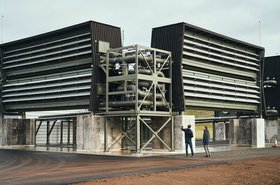Carbon dioxide removal (CDR - also known as carbon capture) is necessary to reach net-zero. Carbon removal is also a distraction from real decarbonization, which is being used to confuse the public and promote the fossil fuel industry.
Both of these things are true.
How can this be? Well, the answer lies in understanding the legitimate purpose of carbon capture, the possible ways to do it, and how much they cost in terms of both energy and money.
The carbon budget
To start from the basics, we know that there are about 3,000 billion tons (Gtons) of carbon dioxide in the atmosphere. We know that in industrial times (from about 1750 to 2007), the human race has added more than 750 net Gtons, and this has raised global temperature by about 1°C.
The rate of emissions has been going up very rapidly. From 1750 to 1960 emissions averaged around 1 Gton per year, and this went up to an average of about 10 Gton by the end of the 20th century and is now about 36 Gtons of CO2 per year.
We can only survive with a certain amount of CO2 in the atmosphere, so there’s a limited amount more we can add. The budget remaining to us is less than 380 Gtons, or about ten years at the current rate of emissions.
To stabilize the temperature, we need to bring our net emissions down to zero, before we spend the total 380 Gtons budget. We are like a household spending more than it earns, and living on its savings. If we can’t balance the books before the reserves run out, we won’t be able to pay our bills.
This means we have to stop burning fossil fuels, leave the remaining reserves in the ground, and make our industry and agriculture produce fewer emissions. Sectors that use fossil fuels for heating, energy, and transport need to switch to low carbon sources - using electricity from renewable sources.
Now, there are some emissions that will be difficult or impossible to eliminate, so in the long run, to stay on absolute net-zero, we will need to have some CDR to remove the carbon we can’t avoid emitting.
But the bulk of the work to get to net-zero has to be done by reducing emissions, not removing them.
CDR is not a substitute for cutting emissions
The reason for this is clear. Many CDR methods are very energy intensive and others use resources like land which are needed for other purposes.
Consider direct air capture (DAC). This uses electrical means to draw carbon dioxide out of the air. DAC uses about 300kWh of electricity for every ton of captured CO2. Electricity has a carbon footprint, varying from 950g per kWh for coal, to 20g for wind. The best use of clean energy is to replace dirty energy, so the emissions don’t get into the atmosphere in the first place.
DAC costs around $1,000 per ton, so to capture a significant amount of today’s emissions, say 1 Gton, it would take a trillion dollars, and a lot of clean power that doesn’t exist. Today, that money would be better spent on measures to reduce emissions.
If carbon removal is presented as a kind of side hustle for the human race, a project to develop something useful for the future, I’m fine with that.
Microsoft is investing in pretty much every carbon removal technology, waste concrete, reforestation in the US and Kenya, biochar in Bolivia and Virginia, capture onto sheets of calcium oxide by Heirloom, and direct air capture by Climeworks in Iceland and Carbon Capture in Wyoming.
If we see that as a way to invest in a future technology and bring down its cost for all, then great. Microsoft has also said that it expects CDR to deal with the stubborn problem of its huge Scope 3 emissions, and that raises questions.
When schemes promise to remove so much carbon dioxide we don’t have to worry about reducing emissions, then that is dangerous greenwash.
Activist George Monbiot is strident: “Carbon capture and storage has been promised for 20 years. It has never materialized and never will. Its sole purpose is to create the impression that oil and gas drilling is compatible with a habitable planet. Any politician promoting it is working for the fossil fuel industry.”
Some oil companies have proposed carbon capture schemes as a way to offset increased production - some “carbon capture use and storage (CCUS)” schemes even suggest pumping captured CO2 into underground oil reserves, to increase the amount of oil that can be extracted. This massively increases overall emissions, and breaks the requirement to stop exploiting reserves.
Time to certify
So, against that background, I’m happy (more or less) to see the European Union (EU) is starting to look at a program to certify CDR schemes. The provisional Carbon Removal Certification Framework (EU CRCF) aims to create solid measures for how much carbon is removed by schemes, and how long it is kept out of circulation
This is progress. Without agreed certification, then CDR schemes are as useless as carbon offsets, which have been roundly dismissed by most people as cheap greenwash because so many are based on dubious accounting.
The EU’s scheme will include an open definition of carbon removal, hopefully in harmony with what is being done by the UN Intergovernmental Panel on Climate Change (IPCC).
It will create a registry holding certificates that will measure CDR projects by "net benefit" (the number of metric tonnes of CO2 equivalent removed by various activities) as well as the length of time the carbon is kept out of circulation.
It will distinguish permanent removal in the ground, which lasts for centuries; and the use of carbon in things like wood construction, which has to hold carbon for at least 35 years, as well as the biogenic storage methods or “carbon farming” such as reforestation or wetland management, which have lower requirements.
While direct air capture (DAC) company Climeworks has welcomed the framework, it’s been criticized by at least one climate group for its laxity, and for loopholes that will allow the same sort of greenwash we saw with carbon offsets.
“The CRCF deal is deeply problematic,” said Wijnand Stoefs, carbon removal policy lead for the nonprofit Carbon Market Watch, in a statement. “Instead of providing the strong foundation for future EU carbon removals policy, the CRCF has plunged it into quicksand.”
Stoefs complains that the framework makes the fundamental error of treating removal as a substitute for emissions reduction. It will also allow double counting, and incentivize short-term storage in soil for periods as short as five years.
“To have any climate benefit whatsoever, temporary storage needs to last for at least a century, as our research demonstrates, not the five years for carbon farming projects or 35 years for carbon storage products under the CRCF,” says Stoefs.
In its favor, the framework at least sets a goal of making CDR measurable.
That’s a start, but it has a long way to go before it’s truly trustworthy as a part of climate change mitigation.








